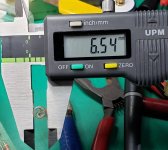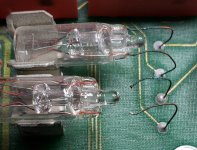Hello everyone, I have a used AP SYS 1, and I smell strange smoke after power-on. I know that the machine has a problem. I disassembled the machine and found that some tantalum capacitors were broken. And the small lamps on the LVF boards and PHA boards are also broken. I don't know where to find these small lamps . Can someone tell me?




The best way is to download the schematics and check the part numbers and description for those parts. The caps values will be in the schematic.
Jan
Jan
The lamp is 48ES type but it seems to been obsolete. Similar 48ESB lamp is still available on Mouser from JKL components, it is almost same diameter and length but with a telephone slide type terminal. I removed the teminal with soldering iron then it fits the holder on the board (not yet replaced).
Another failure of the IEC inlet I found, It was the exact same failure I had seen on the eevblog!
EEVblog #620 - Repair: Stanford Research SR650 Programmable Filter - YouTube
Another failure of the IEC inlet I found, It was the exact same failure I had seen on the eevblog!
EEVblog #620 - Repair: Stanford Research SR650 Programmable Filter - YouTube
Hi wallacetan.
The tantalum caps do short out with age or high ripple currents. I usally replace them with low ESR alum caps. When the S1 started 1984 good alum caps were not made, so we used tantalum as they were small and very low ESR.
The LAMPS 48ES were used to protect the Analyzer input stages from failure. They can cause high CMRR problems as they age. In later versions we made some change’s to the circuit and replaced them with thermistors. If you buy the 48ESB lamps buy several and try to match the DCR’s this will make the CMRR better.
Duke
The tantalum caps do short out with age or high ripple currents. I usally replace them with low ESR alum caps. When the S1 started 1984 good alum caps were not made, so we used tantalum as they were small and very low ESR.
The LAMPS 48ES were used to protect the Analyzer input stages from failure. They can cause high CMRR problems as they age. In later versions we made some change’s to the circuit and replaced them with thermistors. If you buy the 48ESB lamps buy several and try to match the DCR’s this will make the CMRR better.
Duke
The best way is to download the schematics and check the part numbers and description for those parts. The caps values will be in the schematic.
Jan
Yes, Jan, I got the manual from the AP website, except for the little lamps, the broken capacitors are replaced with the same. The description of the small lamp part is a 48V 40mA incandescent lamp, I can't find it on internet.
thx
Tan
The lamp is 48ES type but it seems to been obsolete. Similar 48ESB lamp is still available on Mouser from JKL components, it is almost same diameter and length but with a telephone slide type terminal. I removed the teminal with soldering iron then it fits the holder on the board (not yet replaced).
Another failure of the IEC inlet I found, It was the exact same failure I had seen on the eevblog!
EEVblog #620 - Repair: Stanford Research SR650 Programmable Filter - YouTube
Thank you, Shinja, I am going to order some small lamps from Mouser. For some reason, I cannot enter the website you provided. I believe I already know how to solve this problem.
Tan
Hi Duke,
Thank you for telling me to solve the tantalum capacitor problem in this way. I have replaced it with a tantalum capacitor with a higher voltage than the original. I think it should be no problem. If there is still a problem, I will use your method to repair it.
I will follow the path provided by Jan and Shinja to purchase small lamps and perform DCR matching.
Tan
Thank you for telling me to solve the tantalum capacitor problem in this way. I have replaced it with a tantalum capacitor with a higher voltage than the original. I think it should be no problem. If there is still a problem, I will use your method to repair it.
I will follow the path provided by Jan and Shinja to purchase small lamps and perform DCR matching.
Tan
Oh, my goodness, just add the word "telephone" to search, I can get a lot of these little lamps on the Internet, thank you.
Tan
Tan
Yeah, it took me a long time before I discovered that these were used, ages ago, in telephone equipment. Youth can be a disadvantage ;-)
Jan
Jan
I've been asked for the "Noise Macro" -- here it is as a text file,. Save it as a macro file.
Modify the macro for the gain of the amplifier you use ahead of the AP. In my case it is either the SSM2019 @100x, Sam Groner's @1000X, or a simple JFET @68x
suggestions welcome. you can modify the macro to use a table sweep and sidestep the "nasties" at the multiples of line frequency. the digital filter has a more narrow bandwith but is significantly noisier.
Modify the macro for the gain of the amplifier you use ahead of the AP. In my case it is either the SSM2019 @100x, Sam Groner's @1000X, or a simple JFET @68x
suggestions welcome. you can modify the macro to use a table sweep and sidestep the "nasties" at the multiples of line frequency. the digital filter has a more narrow bandwith but is significantly noisier.
Attachments
Last edited:
In fact, 48ESB's bulb (terminal removed) is shorter hight than 48ES in the S1.
There are various telephone slide base lamps such as 48C, 48PSB, 48ESB etc... from taller to shorter.
ATR Lighting | 48C | 14654ATR | ATR Lighting
ATR Lighting | 48PSB | 14670ATR | ATR Lighting
ATR Lighting | 48ESB | 14664ATR | ATR Lighting
48PSB may be the same height to S1's, not sure though...
There are various telephone slide base lamps such as 48C, 48PSB, 48ESB etc... from taller to shorter.
ATR Lighting | 48C | 14654ATR | ATR Lighting
ATR Lighting | 48PSB | 14670ATR | ATR Lighting
ATR Lighting | 48ESB | 14664ATR | ATR Lighting
48PSB may be the same height to S1's, not sure though...
I am having a hard time in a 2722 macro pulling up a Sweep Table. Perhaps the system doesn't like the Win10 conventions.
If I use: AP.Sweep.Source1.Table ("file///c:/users/jdwal/Documents/Audio%20Precision/Macros/Noise3.ads",0)
I get error message 9033 "Invalid Filename Specified"
If I use: ("c:\users\jdwal\Documents\AudioPrecision\Macros\Noise3.ads",0)
I get error message 9002: "Could not open file"
No problem using the sweep table manually, would be nice to have it in the macro.
If I use: AP.Sweep.Source1.Table ("file///c:/users/jdwal/Documents/Audio%20Precision/Macros/Noise3.ads",0)
I get error message 9033 "Invalid Filename Specified"
If I use: ("c:\users\jdwal\Documents\AudioPrecision\Macros\Noise3.ads",0)
I get error message 9002: "Could not open file"
No problem using the sweep table manually, would be nice to have it in the macro.
Hi,
Thanks for sharing the details for the 48esb bulb.
My AP Sys One just broke last week.
The generator was completely dead and the analyser section is only reading strange numbers.
I started with the generator. After investigation and following the bad smell, I figured out that the output stage of the amplifier smoked.
After replacing the following components : all the 2.2R, 2n5086 (replaced by a bc560), TIP31 & TIP32, the generator is working again.
Unfortunately something is wrong with the out signal, the THD is quite high 0.00200%. Before the AP had 0.00053% THD for the same signal :1vrms@ 1KHz
I also notice that the out+ and out- do not have exactly the same level, not sure if it was already the case before or not. This is only happening after the out transformer, before the amp+ and amp- signal have strictly the same level.
Any idea what could cause this THD and level issues?
Regards
alex
Thanks for sharing the details for the 48esb bulb.
My AP Sys One just broke last week.
The generator was completely dead and the analyser section is only reading strange numbers.
I started with the generator. After investigation and following the bad smell, I figured out that the output stage of the amplifier smoked.
After replacing the following components : all the 2.2R, 2n5086 (replaced by a bc560), TIP31 & TIP32, the generator is working again.
Unfortunately something is wrong with the out signal, the THD is quite high 0.00200%. Before the AP had 0.00053% THD for the same signal :1vrms@ 1KHz
I also notice that the out+ and out- do not have exactly the same level, not sure if it was already the case before or not. This is only happening after the out transformer, before the amp+ and amp- signal have strictly the same level.
Any idea what could cause this THD and level issues?
Regards
alex
Hi Alex
Run a THD% sweep from 26 volts to 10 mv 500 points @ 1kHz and THD% 20kHz -20Hz 1 volt 50 points. send me the file.
duke.aguiar@ieee.org
Run a THD% sweep from 26 volts to 10 mv 500 points @ 1kHz and THD% 20kHz -20Hz 1 volt 50 points. send me the file.
duke.aguiar@ieee.org
- Home
- Design & Build
- Equipment & Tools
- Audio Precision AP Analyser series